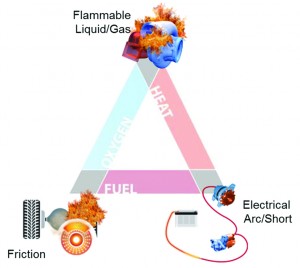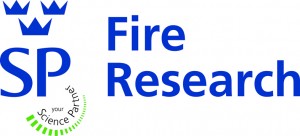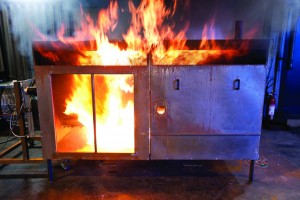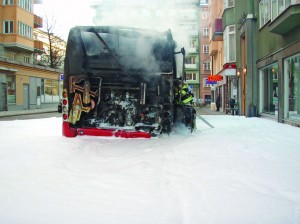By Fredrik Rosen, Marketing Manager at the Department of Fire Technology – SP Technical Research Institute of Sweden, and Joey Peoples
Bus transportation is regarded as one of the safest modes of public transportation. Millions of passengers ride safely by bus every day, and bus manufacturers and operators have gone to great lengths to establish and maintain the safety record. However, a fire resulting from a collision or failure of a component puts lives at risk and can have an enormous impact on operational costs as well as customer confidence.
Aircraft, trains and passenger ships all have well-established standards, regulations and certification processes to ensure maintenance of high levels of safety as new materials and constructions are introduced. Buses, on the other hand, mostly rely on the efforts of the OEMs, operators and suppliers of fire systems to ensure safety with few strict regulations.


Bus fire safety encompasses many aspects of design, operation, maintenance, evacuation and even first responders. All have a critical role in establishing effective standards and best practices, but are typically the responsibility of different stakeholders in the development process.
Buses pose many unique challenges in regard to fire risks. The varying modes of operation (city, highway, long distance), unique vehicle types (school, transit, coach, demand response) and design changes to meet new emissions standards provide the context for fire safety. But each fire hazard, whether it is an engine compartment, battery compartment, wheel well or even a luggage compartment, poses unique challenges in the way of geometry, airflow, clutter, flame spread and evacuation. This can be summarized in a modification of the traditional fire triangle to the specific situation for buses and coaches as shown in Figure 1.
The engine compartment which is one of the more well-known fire risks poses several challenges that effect the detection and suppression of fires. Ventilation, through fans and openings in the engine compartment, can produce high levels of airflow. This facilitates necessary cooling of the engine and compartment but can also increase the intensity and spread of flames which can have an enormous impact on fire detection times and suppression system effectiveness.
The varying designs, geometry and clutter clearly represent risks that need to be analyzed. The first step in this process, and perhaps the most important one, is to conduct a thorough fire risk analysis which should include a failure mode effects analysis (FMEA) during the design phase. FMEA will identify the highest risks with regard to occurrence and severity and what methods are used to detect them. This will help ensure that maintenance practices and training address the risks identified.
The first few months of operation and operation in all seasonal conditions are also critical. High temperatures created in the engine compartment can cause premature failure of components and potentially increase surface temperatures which could ignite flammable fluids more readily than expected. The use of temperature strips in high-risk areas to identify unexpected high temperature zones is, for instance, a good “best practice”.
Needless to say, fire prevention is an ongoing process; and, even when dealt with vigilantly there is always some residual risk of an event as seen in Figure 2. Most would see this as unfortunate accident, and we can sometimes believe that determining the origin and cause resolves the problem. Such incidents could also be viewed as one of the most important learning tools at the disposal of stakeholders which can provide critical input into best practices for design, operation and human factors.
SP Fire Research
SP Fire Research is part of SP Technical Research Institute of Sweden and is one of the largest fire research facilities in the world with capabilities to conduct fire testing on full-size buses. Staffed by researchers, engineers and industry experts it offers a complete solution for evaluation, testing and risk analysis of innovative technologies and solutions.
Since 2004 SP has promoted global bus fire safety as a top priority. As part of this work SP has been active in the development of standards and test methods specific to vehicle hazards. The aim of such test methods is to establish performance-based standards for the objective evaluation of safety performance of products and solutions. Products are tested for performance against realistic fire scenarios and environmental aspects specific to the hazard.
Most recently, SP has been involved in the investigation of an incident in the south of Sweden where two gas buses collided and started to burn. The work was commissioned by the Swedish Accident Investigation Authority. The reason for fire was that gas ignited oil in the engine compartment. As part of the investigation a full-scale reconstruction of the bus fire was carried out in order to establish the cause of ignition and answer the question of why the fire suppression system did not manage to extinguish the fire (see Figure 3).
The investigation led to a number of conclusions and recommendations from the Swedish Accident Investigation Authority to the Swedish Civil Contingencies and the Swedish Transport Agency, indicating a pressing need to:
– develop procedures for first responders how to approach CNG bus fires
– establish requirements for fixed fire suppression systems in engine compartments
– require function control of fire suppression system in conjunction with the regular vehicle inspection
– extend professional driver training for bus drivers with exercises in fire safety and evacuation.
New International Standard/Certification for bus engine fire suppression
SP Fire Research is leading the way for more effective fire suppression systems by establishing a certification process (SPCR183) and test method (SP test method 4912) for testing fire suppression systems against known fire threats and environmental conditions specific to bus engine environments. Successful systems are then issued a certificate and allowed to “P” mark their components.
Several fire tests conducted on operational buses have confirmed that the pass/fail criteria used in the certification demonstrate a high level of protection. More than 20 various types of systems (dry chemical, water based, aerosols, gaseous, etc.) are pursuing the “P” mark. Several systems have already been approved or are in the final stages of approval.
Adoption of the standard is becoming more common around the globe. For instance, US Transit operators are among the first to actively include the “P” mark in their procurement specifications.
Growing fire safety awareness
All over the world there is growing awareness related to fire safety. Government agencies, industry associations, OEMs, operators and even special advocacy groups have formed committees and knowledge platforms to discuss the issues.
In the US, efforts are underway at both the federal and state levels to improve bus fire safety. These efforts have included research and testing and adoption of automatic fire detection and suppression systems.
All modes of bus transportation in the US are using some form of automatic fire systems. Some make it mandatory for all vehicles while others focus on vehicles where evacuation issues are a concern.
The United Nations Economic Commission for Europe (UNECE) is considering a proposed change to Regulation 107 which could require installation of fire suppression systems in the engine compartment of all single-deck, double-deck, rigid or articulated vehicle of category M2 or M3.
Fire safety in buses has been the focus of significant research in recent years, but much improvement still remains, in particular related to fire prevention and safe egress. The sharing of information and best practices can benefit all parties, but, most importantly, the bus passengers.
SP will be publishing its top most wanted fire-related issues, of which a few are listed below. Some projects have already been funded and are in progress, while others are awaiting funding opportunities:
Wheel well fires (containment, preventing fire through window): The exposed environment and deep-seated fire risk makes wheel well fires particularly difficult to detect and suppress. Tests have shown that it can take less than five minutes before toxic fumes and smoke enter the passenger compartment. Tire pressure/temperature monitoring systems represent one method for early detection, and other methods need to be explored. Early testing of some coatings in the wheel well area have been shown to provide a significant increase in the evacuation time before toxic fumes enter the passenger compartment. Continued work in this area could provide a low-cost solution.
Bulkheads/fire partitions (smoke tightness): The bulkheads between high risk areas such as the engine compartment and the passenger compartment can allow toxic fumes and flame spread into the passenger compartment. New materials present new challenges as does the increased complexity of systems connecting from the engine compartment into the driver area. Methods to contain the fire in the engine compartment would mean better passenger safety and less damage from flame spread.
Detection systems
SP is currently working on a project funded by the Strategic Vehicle Research and Innovation Foundation in Sweden, an independent funding agency. The project has several co-financing partners, including vehicle manufacturers, insurance companies, end users, a transport agency and several suppliers of fire detection systems for vehicles. One part of the project aims to develop a new test method and propose a standard for fire detection and fire alarm systems in heavy vehicles.
Further, the project will investigate non-traditional methods such as predictive failure modes for high risk components, facilitating rapid identification of pending failures to hoses and lines carrying flammable fluids or components that have greatly exceeded their operational parameters.
The need for lighter, less costly materials is always present; but there are very few standards and regulations regarding flammability and toxic fume production of such material. Further research is necessary to establish adequate performance requirements for the use of flammable material in high risk areas in buses and coaches.
Electrical fires pose as many challenges as wheel well fires. Electrical arcing and shorts do not always trip protective devices such as fuses. Some cables, e.g., those used from the battery to the starter and alternator, carry very high currents capable of producing enough heat not only ignite nearby combustible materials, but also to cause breaches in hydraulic lines and metal covers.
In order to stop a potential electrical fire it is necessary to remove the current to the effected cable. Adoption of best practices for routing, securing and protection can greatly reduce the risks. Early detection methods such as current monitoring or better circuit protection should be explored.
Alternative fuels
All over the world, new alternative fuels are emerging to replace fossil fuels such as gasoline and diesel. Hybrids, natural gas, all-electric and even hydrogen buses are being currently used. The overall benefit is great, but with new fuels and technical solutions, the fire risks change. In addition, first responders face new risks. Alternative fuel fires as with ethanol can also to some extent be more challenging to extinguish. Ethanol is a water miscible fuel that requires the use of alcohol-resistant foam concentrates. Other foams are destroyed very quickly. Gentle application of the foam is also very important (see Figure 6).
Some countries have been using alternative fuels for more than 20 years. Others are just beginning to act. One hindrance to the introduction of alternative fuels is the perception that they may result in explosions and increased risk. Dissemination of present knowledge and development of new data is key to large-scale introduction of alternative fuels.
SP in, cooperation with Chalmers University, has recently opened one of Europe’s largest test and research facilities for Active Safety – ASTA ZERO (Active Safety Test Area AB). ASTA ZERO is a state-of-the-art test facility specifically designed for developments in active traffic safety and includes unique environments to build any scenario in order to develop, test or certify new traffic safety solutions; making it possible to test literally all aspects of active safety in one place.
Where do we go from here?
Responsibility to ensure safe travel on buses should be shared by all parties. Establishing standards and best practices will ultimately mean less legislation or at least legislation that is backed by sound scientific knowledge and best practices. Very little data exists to specifically identify the quantity, type and cause of bus fires. In addition, the limited legislation, standards and best practices that are in place aren’t always readily available.
In the near future links to known organizations, committees and other sources of information will be published on the SP website along with conferences at which fire safety is on the agenda.







